Can Your Clinical Patients Benefit From Good Human Practices?

By Ed Miseta, Chief Editor, Clinical Leader

Nektar Therapeutics is attempting to create a new experience for sites and patients taking part in clinical trials. With over 25 years of experience in clinical trials, Eileen Daniel, Nektar’s Executive Director of Clinical Operations has been instrumental in bringing together leaders within the company to make the vision a reality. Just a few years ago, her frustration over how some companies handled communications with sites and patients almost caused her to leave the industry. Now, she is excited about efforts being made to better engage both groups, and feels the future looks bright.
One of the first things Nektar did was make changes to how it selected CROs and the process whereby it communicated with both CROs and clinical sites. I will not cover that process here, but you can read about it in the November issue of Life Science Leader magazine. The company then set out to find ways to better interact with patients. This site and patient effort is collectively referred to as Good Human Practices (GHP).
Examine The Supply Chain
 Supply chain considerations are important to the patient experience, and this was one of the areas it made a priority. “In our study team launch meetings with CROs and other stakeholders, we have a breakout session around drug supply,” notes Daniel. “A lot of detailed planning goes into the drug supply strategy months and years in advance, but simulating for the patient experience is something that people at many companies simply aren’t used to doing.”
Supply chain considerations are important to the patient experience, and this was one of the areas it made a priority. “In our study team launch meetings with CROs and other stakeholders, we have a breakout session around drug supply,” notes Daniel. “A lot of detailed planning goes into the drug supply strategy months and years in advance, but simulating for the patient experience is something that people at many companies simply aren’t used to doing.”
Within that launch meeting Nektar includes drug supply reps as well as individuals from the CRO who manage site interaction and drug supply. Representatives of Nektar’s drug depot were also there; as the company went all-out to make sure it had everyone in attendance that needed to be a part of the process.
“We asked everyone to come prepared with anything we would need to analyze the supply process,” notes Daniel. “We had people show up with mockups of drug wallets, placebo tablets, and anything else they thought we might need. We were able to walk through what the site would receive, what it would look like, and how much space it would take up. We were able to see what the patient experience would be like when they got their drugs and what they would see when they opened the wallet card. It helped us to determine whether patients interpreted the instructions as we intended.”
Daniel stresses it is important to make sure everyone attending such a meeting knows what to expect. This is not a PowerPoint presentation where everyone simply receives information. She describes the meeting as more of a process of discovery. While that makes the meeting a challenge to plan and conduct, it also makes it more rewarding. No one in attendance really knows what they will discover until they take the time to work through the entire process.
“We might open a simulation meeting telling people we are going to play a game,” she says. “With some participants you can see their faces light up, and with others you will see some eye-rolling. You can probably expect some to ask if they really have to play, and even question why they are there. Eventually you see people picking up the wallets, moving them around, and discovering how many tablets are in them. We can see how 20 of the wallets will look when they stack up and then the realization of impact on storage space at the sites starts to sink in. You really don't know what you might discover. It’s amazing what you can happen when you have smart people from all different viewpoints in the same room figuring it all out.”
Learn From Trial Simulations
There is a lot that can be learned from having fifty smart pharma people sitting in a room talking about drug supplies and delivery, and playing with the wallets. But eventually it is a patient that will have to deal with the product. For someone who hasn’t seen and handled the product before, and doesn’t understand it, this can be an entirely different experience.
Nektar knew it needed to do something more than get the reactions of its own team members and partners, so the company decided to have a trial simulation even before the study team launch meeting. A company familiar with market research was hired to assist with the effort, which included bringing in a principal investigator and patients who had the required indication. They were put in a room with one-way glass and were asked to walk through key parts of the protocol where the company felt it needed additional input. Other team members at the headquarters site watched via a video stream.
“We watched as the physician walked through the process of consenting a patient,” notes Daniel. “We also watched as the physician and a coordinator explained to patients how the proposed drug wallet card would work, to see how well patients understood how they were to take their study medication.”
Daniel describes the experience as incredible. That simulation showed the entire team aspects of the study that would have to be modified prior to kicking off the study. If these issues were not discovered until later, it could have been difficult to change direction without impacting the timelines of the clinical trial.
“There were several changes made, to the outer packaging and the process of getting it into the patient's hands, that we might not have known were necessary if we hadn’t performed the simulation,” she says. “Many of the comments were simple things to fix, such as ‘It would really help if we had a space to make a note on the wallet card,’ or, ‘It would help if the words were oriented this way instead of that way.’ We celebrated the things we did right, and modified the things that would create a better experience for the patients and the physician.”
Take The Time To Know Site Personnel
Today, many companies are trying to get things done as quickly as possible. The goal is generally to get sites up fast and make sure that recruiting and enrollment efforts get patients in the door as quickly as possible. Nektar took a slightly different approach of selecting ten sites that were known to both the company and the CRO and invested heavily to engage them early
“We accelerated the start-up process for these first ten ahead of other sites,” says Daniel. “We let them know we would focus on their experience and would delay other sites for a while, because we needed to know if our protocol translated into their reality.”
She notes the sites were a bit stunned by that revelation. The ten companies were invited to Nektar headquarters and eight of them were able to attend a weekend meeting on just three weeks’ notice. Attendees included program directors and key team members.
“They came in and we had a meeting similar in structure to our study team launch meetings,” says Daniel. “In a setting that facilitated discussion, representatives from Nektar and our CRO talked to them about the protocol, recruitment, materials, drug supply, and other considerations. We talked over dinner and then for around six hours the next day.”
Upon conclusion of the meeting Nektar solicited feedback from each company. “I've been doing clinical trials for thirty years,” said one site director, “and I have never been invited to have this kind of conversation with a sponsor, let alone in their headquarters. It is a new experience altogether. Normally our only contact with the sponsor company is through the CRO.”
Find A Dedicated CRO Team
I have spoken with numerous representatives of pharma companies who will complain that when first meeting with a CRO they are introduced to the A-Team, only to have them replaced with a different team once the study is underway. That was a concern for Nektar as well. Daniel knows this can be a problem for any CRO, as employees often can and will change jobs.
She notes Nektar will insist that CRO employees assigned to projects be fully allocated and dedicated to the program. They prefer individuals who have worked together on other projects and know each other well. Daniel’s team can vet this out during pre-selection meetings where more complex questions are raised. If CRO employees do not know each other well, it becomes obvious in their responses.
“We also make sure to know our CRAs really well,” says Daniel. “If someone is touching a site, we get to know them face-to-face and ensure they have from our mouths, what is most important to the program.”
Ultimately the goal of any clinical trial is to gather data that can be submitted to the FDA for an approval. GHP is about improving the trial experience for patients and sites, so as to get the best data possible. According to Daniel, helping everyone involved in the trial realize they are working on the same team is critical to being successful.
Nektar has three tenets for any of its clinical trial programs: protect the primary endpoint, optimize the experience for sites, and optimize the experience for patients. To accomplish them, everyone needs to be pulling in the same direction. “Anything that anyone does affects the company, the CRO, the sites, and ultimately rolls down to the patient. Everything each of us does matters to that patient.”
